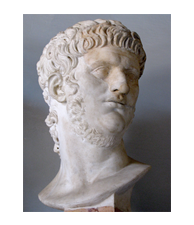One Column Page
and responsive to boot
A Case for the Beast as Israel and the Zealots
by
Adam Maarschalk
This article appeared in the 2021 Fall issue of Fulfilled! Magazine
A key part of
what John wanted to communicate to his first-century readers
concerned the beast, with more space given to this topic
than to the harlot, the two witnesses, New Jerusalem, and
other notable eschatological themes. John warned that some
of his contemporaries would worship the beast and receive
God’s wrath and fiery torment (Rev 14:9-11), while others
would overcome the beast and stand on the sea of glass and
sing the song of Moses and the song of the Lamb (Rev
15:2-4). So there’s no doubt that the beast was a great
enemy to the church, but who was this enemy?
.

Not long after I embraced
fulfilled eschatology in 2009, I also embraced the view that
the beast was Nero and the Roman Empire. After all,
Apollonius of Tyana (AD 15-98) referred to Nero as “a
beast.” After all, using Hebrew gematria a form of Nero’s
name, “Nrwn Qsr,” is said to equal “666.” After all, Nero
persecuted Christians.
As time went on, though, I
realized that I couldn’t reconcile the Rome/Nero model of
the beast with several passages in Daniel and Revelation. I
decided it was time to restudy and reconsider this topic.
I’d like to highlight, in summary
form, eight pieces of evidence which I believe show that the
beast was Israel, and in particular the Zealot movement
which captured the loyalty of so many Jews in the first
century.
A Summary of Evidence that the
Beast Was Israel
1. Revelation 11 states that the
beast would kill the two witnesses (v. 7) in Jerusalem (v.
8), and in that same hour an earthquake would kill 7,000
people (v. 13). Josephus describes an earthquake which took
place in early AD 68 (Wars 4.4.5). That same night an
army of Idumeans, hired by the Zealots, went on a murderous
rampage. The next morning 8,500 dead bodies were found (Wars
4.5.1). Ananus and Jesus, two former high priests, were not
allowed to be buried (Rev 11:9; Wars 4.5.2). Who
could have killed the two witnesses when that earthquake
took place in Jerusalem? From November AD 66 to April AD 70,
Jerusalem was fully controlled by the Zealots; the Romans
were not there.1
2. In Revelation 13:4 those who
worshipped the beast proclaimed, “Who is like the beast? Who
is able to make war with him?” Judah Maccabee is said to
have carried the following expression on his standard in
battle around 165 BC: “Who is like unto thee among the
mighty, O Lord!?” This expression is strikingly similar to
the wording of Revelation 13:4, which very well could have
been said about the Zealots when they slaughtered the Roman
garrisons at Masada and Jerusalem (Wars 2.17) and
surprisingly defeated the armies of Cestius Gallus in
November AD 66 (Wars 2.19). Historians have noted that the
Zealots intended to once again make Israel fully independent
just like the Maccabees did.2
3. Revelation 13 depicts a second
beast, later called “the false prophet,” working closely
with the first beast and performing signs and wonders.
Josephus repeatedly spoke of false prophets working closely
with the Zealots (e.g. Wars 6.5.2), promoting their
war agenda (e.g. Wars 2.13.4-6), and claiming to
perform signs and wonders (e.g. Antiquities 20.8.6;
Wars 7.11.1).
4. The fifth bowl judgment (Rev
16:10) was poured out “on the throne of the beast,”
resulting in darkness, sores, and pain throughout his
kingdom. In Leviticus 26:18-28 God repeatedly warned Israel
that they would one day be punished “seven times”3 for their sins, as God would execute the vengeance of His
covenant (v. 25). It’s no coincidence that the covenant
imagery of Mount Sinai (Exod 19) appears in the opening of
the seventh seal, the sounding of the seventh trumpet, and
the pouring out of the seventh bowl.4 Those
seven-fold judgments were reserved for Israel alone. So
it follows that when the fifth bowl judgment was poured out
“on the throne of the beast,” it was Israel, not Rome, which
was the kingdom of the beast and experienced that darkness
and pain.
5. Revelation 16:13-14 describes
the dragon, beast, and false prophet working together to
gather a multitude to a great battle. Josephus described how
the Zealots and false prophets worked together to compel the
people of Israel to go to war against Rome, killing and
torturing those who resisted their agenda (e.g. Wars
5.1.5, 5.8.1, and 6.5.2).
6. In Revelation 17:16, John was
told that the 10 horns of the beast would make the harlot
desolate, eat her flesh, and burn her with fire. Ten Jewish
generals were appointed to oversee the war effort in
December AD 66 (Wars 2.20.3-4).5 Josephus blamed the Zealots for the destruction of Israel,
Jerusalem, and the temple (e.g. Wars 4.6.3, 5.1.1,
5.1.5, and 5.6.1). He blamed them for the fire that consumed
the temple (e.g. Wars 5.1.4, 5.4.4, 6.2.9, 6.4.5,
6.6.2). He even referred to them as a wild beast eating its
own flesh (Wars 5.1.1; compare with Wars
4.9.8; Wars 4.4.3; 1 Cor 15:32; 2 Peter 2:1, 12; and
Jude 10).
7. In Revelation 19:19-20, it’s
stated that at the coming of Christ the beast would be
captured and cast into the lake of fire. This did not happen
to either Nero or Rome in the first century, but it did
happen to the Zealot leaders of Israel, thus fulfilling
Revelation 13:10 (“He who leads into captivity must go
into captivity . . .”). For example, two Zealot leaders,
responsible for taking many people captive, met the
following fate: John Levi of Gischala was taken captive by
the Romans and “condemned to perpetual imprisonment” (Wars
6.9.4) and Simon Bar Giora was captured, paraded, tormented,
and executed (Wars 7.2.2 and 7.5.1-7).
8. In Matthew 21:43-45 Jesus
stunned the religious leaders of Israel by declaring that
the kingdom of God would be taken from them and given to
another nation. His statement sourced prophetic passages in
Daniel 2 and 7 about the transition from the fourth kingdom
to the everlasting kingdom of God. Let’s compare these
passages, taking note of the parallels (A, B, C, D, and E):
“Therefore I say to you,
[A] the kingdom of God will be taken from you and [B]
given to a nation bearing the fruits of it. And whoever
falls on [C] this stone will be broken; but on
whomever it falls, it [D] will grind him to powder.
Now when the chief priests and Pharisees heard His parables,
they perceived that [E] He was speaking of them”
(Matt 21:43-45 NKJV).
“You watched while [C] a
stone was cut out without hands, which [D] struck the
image on its feet of iron and clay, and broke them in pieces.
Then the iron, the clay, the bronze, the silver, and the
gold were [D] crushed together, and became like chaff
from the summer threshing floors; the wind carried them away
so that no trace of them was found. And [C] the stone
that struck the image became a great mountain and filled the
whole earth. . . . And in the days of these kings the God of
heaven will set up [A] a kingdom which shall never be
destroyed . . .” (Dan 2:34-35, 44 NKJV).
“The fourth beast shall be
[E] a fourth kingdom on earth, which shall be different
from all other kingdoms, and shall devour the whole earth,
trample it and break it in pieces, . . . Then [A] the
kingdom and dominion and the greatness of the kingdoms
under the whole heaven, shall be [B] given to the people,
the saints of the Most High. His kingdom is an
everlasting kingdom . . .” (Dan 7:23, 27 NKJV).
In Nebuchadnezzar’s dream, the
legs and feet were the fourth kingdom (Dan 2:33, 40). The
head was Babylon (v. 38) and the feet were the final stage.
When the stone struck the feet, they shattered, the statue
was crushed (vv. 34-35, 44-45), and the kingdom of God was
set up (vv. 35, 44).
In Matthew 21, who did Jesus
identify as the “feet of iron and clay” that would soon be
crushed by the stone? Didn’t Jesus portray Israel, not Rome,
as the entity which would be destroyed when the kingdom was
taken from them and given to the saints? Rome was neither
crushed nor in its final stage when the saints received the
kingdom, but Israel was crushed.
The fourth beast of Daniel 7 was
a fourth kingdom (vv. 7, 17, 23) and the beast in the book
of Revelation. Daniel watched as the “beast was slain,
and its body destroyed and given to the burning
flame” (v. 11). This was not Rome’s fate, but Israel
was destroyed, and Jerusalem was burned (Matt 22:7; Rev
18:9, 18).
For more details about the beast from this perspective, my ongoing series on the beast can be found at the following link: adammaarschalk.com/beast-of-revelation/.
1 For
more details, see
adammaarschalk.com/2017/02/04/the-two-witnesses-killed-by-the-beast-revelation-113-13/.
2 For
more details, see
adammaarschalk.com/2017/07/14/who-can-make-war-with-the-beast-revelation-134.
3 For
more on the significance of “seven” in Revelation, see
adammaarschalk.com/2016/08/01/the-significance-of-the-number-7-in-the-book-of-revelation.
4 For
more details, see
adammaarschalk.com/2014/03/25/echoes-of-mount-sinai-in-the-book-of-revelation.
5 For
more details, see
adammaarschalk.com/2016/07/11/josephus-lists-the-10-horns-who-received-authority-for-one-hour-revelation-1712/.
Comments:
Your honest review will help others in their search for truth. If you must leave a negative review please be gracious.
Rather, speaking the truth in love, we are to grow up in every way into him who the head, into Christ . . . .
(Ephesians 4:15)
We have migrated to "Disqus" commenting software. Older comments (if any) are archived below, but any new comments on this page will be handled by Disqus. If you are not familiar with "Disqus," click here for more information. You don't need a Disqus account to post comments, however, without an account you won't be notified if someone responds to your post.
Archived Comments:
Craig Lewis, August 22, 2022
Seems like the beast of Revelation 11 (Nero) is not the same as the beast of Revelation 17 (Independent Nation of Israel). Fulfilled
Fulfilled